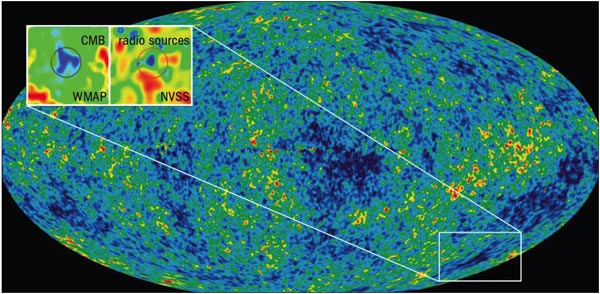An enormous void, nearly a thousand million light-years across, seems to be at the origin of a cold spot that the Wilkinson microwave anisotropy probe (WMAP) has found in the cosmic microwave background (CMB). This region, largely empty of galaxies and dark matter, is much larger than voids observed or predicted using computer simulations.

Image credit: NASA/WMAP Science Team and Rudnick et al. NRAO/AUI/NSF.
The map of temperature fluctuations in the CMB as observed by WMAP shows a distinct feature known as the "cold spot". Some attempts to explain this peculiar feature have invoked non-Gaussian processes to alter the radiation when it was emitted about 400 ,000 years after the Big Bang. Alternatively, the observed radiation could also be modified on its journey of thousands of millions of years from the outer regions of the universe to the Earth.
For instance, a CMB photon can gain energy by "falling" into the potential well of a dense region, such as a cluster of galaxies. Normally, it should lose the same amount of energy again when moving out of this area. However, under the effect of dark energy the potential well becomes less deep with cosmic time and the energy loss of the photon will not balance its earlier energy gain completely. This subtle effect – known as the "late integrated Sachs–Wolfe effect" – would make a hot spot in the map of the CMB in the line of sight of a galaxy cluster. In the opposite case of an extended void in space, the net effect on the CMB map would produce a cold spot.
Is there something special about the distribution of galaxies in the direction of WMAP’s cold spot? This is what Lawrence Rudnick from the University of Minnesota wondered. Investigations are based on the NVSS – the National Radio Astronomy Observatory (NRAO) Very Large Array (VLA) Sky Survey. The NVSS programme observed 82% of the sky visible from the VLA location in New Mexico from 1990 to 1997 and produced a catalogue of more than 1.8 million individual radio sources. By smoothing these observations to a resolution of a few degrees, Rudnick found a clear dip exactly at the position of the WMAP cold spot. Both the radio intensity and the number of radio sources are lower in this region of the river constellation Eridanus.
As radio sources are good tracers of the presence of galaxies – and thus of mass in the universe – it makes sense to assume that the WMAP cold spot comes from this dip in the projected distribution of galaxies through the late integrated Sachs–Wolfe effect. Rudnick and colleagues estimate the size of the volume that would need to be almost empty of matter to explain the cold spot of WMAP through this effect. The result is a big void of almost a thousand million light-years in size, which should be located in the relatively nearby universe – at most, at a redshift of z ˜1 – when the effect of dark energy starts to dominate the expansion rate of the universe (CERN Courier September 2003 p23). Such a big void exceeds by far the size of known regions of empty space and also the expectations of computer simulations of large-scale structures (CERN Courier September 2007 p11). Therefore, the WMAP cold spot remains a puzzle, no longer as a peculiarity of the very early universe but as an oddity of the time of structure formation.





